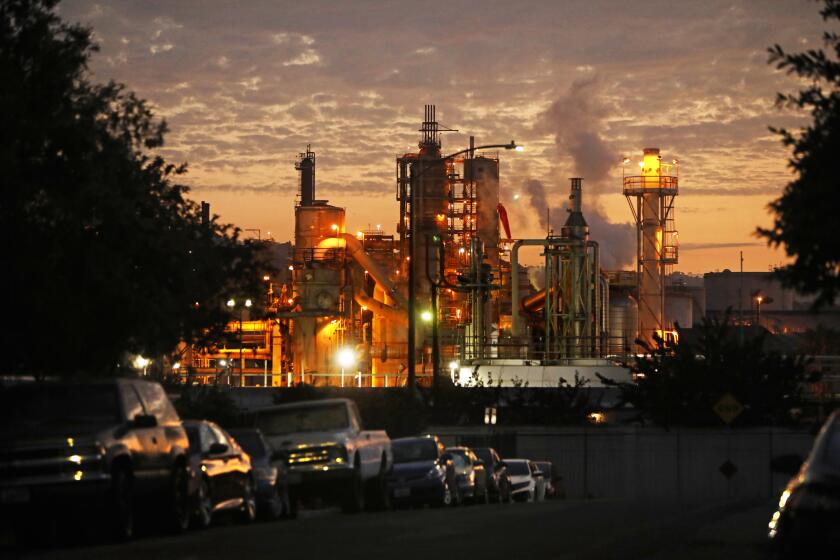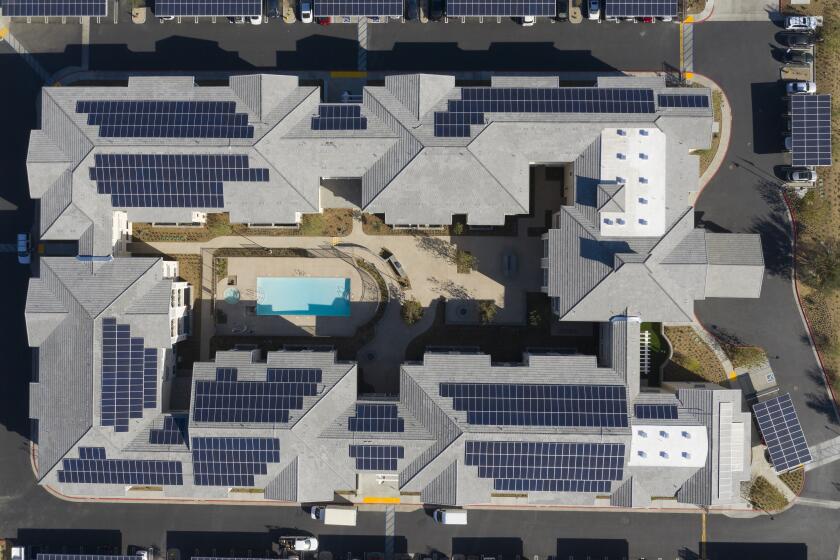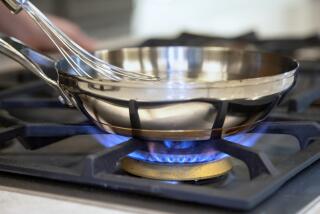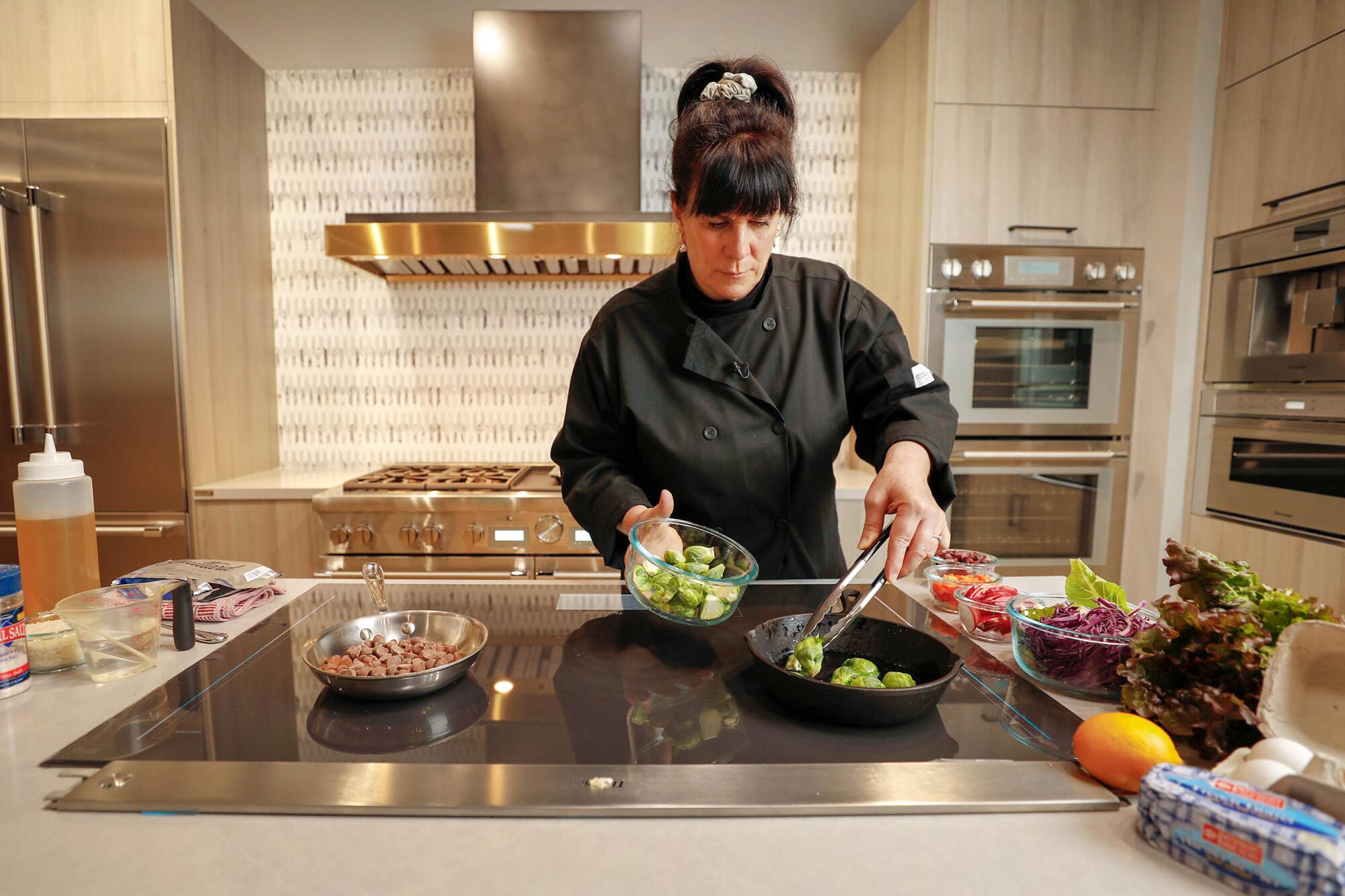
- Share via
BERKELEY — The most luxurious gas stoves and ovens a home chef could desire fill the cavernous Snyder Diamond showroom in Van Nuys, but the cooking appliance the owner seems most excited about doesn’t use gas at all — or look like an appliance.
“You don’t even see it,” Russ Diamond said of a stealthy induction range soon to arrive in his showroom. It doesn’t intrude on a stone or porcelain countertop because it is the countertop.
The range can sense when a pan is on it and uses an electromagnetic field to zap heat into the metal. Chefs can sear meat, singe veggies and boil water ridiculously fast, Diamond says. Lift the pan, and the counter cools instantly.
The promotional buzz at this high-end showroom marks an early salvo in a multimillion-dollar battle over the way Americans cook, one that pits the fossil fuel industry against a California-led movement aimed at turning off the natural gas spigots to slow climate change.

More than 50 California cities have restricted or banned natural gas hookups in homes and businesses to combat climate change. Some researchers have also linked gas stoves to a higher risk of asthma. L.A. Times reporter Evan Halper digs into how electric cooking alternatives such as induction stoves can benefit the environment and our health. But are cooks willing to give up cooking with fire?
Impatient with the pace of climate action, more than 50 California cities have passed rules that restrict — and in many cases ban — natural gas hookups in new homes and businesses. The movement has quickly spilled far beyond the state’s borders.
Its success relies on convincing home cooks that they don’t need a gas range.
“We know the climate can’t afford us to continue using natural gas for the next 50 or 100 years,” said Billi Romain, manager of the Office of Energy and Sustainable Development in Berkeley, the city that started this all with the nation’s first gas ban in 2019. “But if you build a building using natural gas, you are making a 50-, 100-year investment…. We really need to stop that investment pipeline into gas infrastructure.”
The International Energy Agency recommended in May that governments worldwide ban fossil fuel furnace sales by 2025 and move urgently to phase out the use of natural gas in buildings. In California, it accounts for about 10% of the state’s greenhouse gas pollution.
Electric cars, climate credit schemes, diverse boardrooms and legal weed: How California exports its ideas and policies across the U.S.
Berkeley is now among cities drafting blueprints to cap off the gas lines even on existing homes and businesses. Ithaca, N.Y., last month passed just such an ordinance. Inspired by the grass-roots push in California, cities throughout the Northwest and Northeast are moving forward on bans for new construction and remodels. In New York City, which accounts for 5% of the gas burned in buildings nationwide, a ban passed by the City Council on Wednesday is expected to be signed by the mayor. Twenty cities in Massachusetts are pursuing bans.
A gas industry counteroffensive, meanwhile, has pushed 19 fossil-fuel-friendly states to prohibit any local bans. Champions of those state laws often invoke California as the progressive boogeyman.
“Don’t California My Florida,” warns a pamphlet from an organization called Power Florida Forward, one of many industry-backed groups formed around the country to keep the gas lines flowing. It goes on to suggest gas hookup bans caused rolling blackouts in California, a claim for which there is no evidence. The fossil-fuel-friendly Texas Public Policy Foundation cheered that state’s prohibition on cities restricting gas use by branding “California-style bans on natural gas utilities” as “arbitrary constraints on Texans’ freedom.”
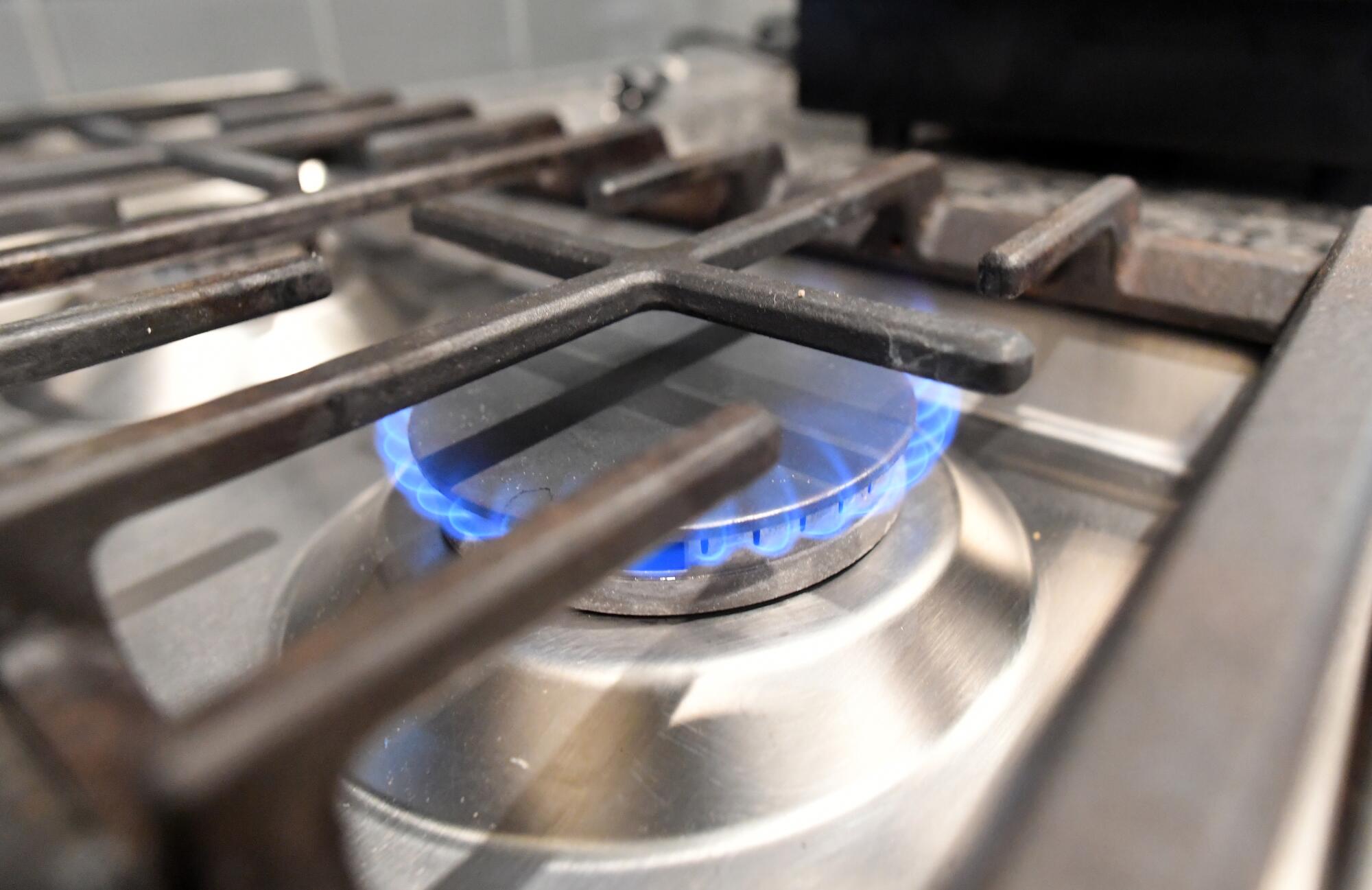
It is an argument the gas industry is eager to move into the kitchen. Swapping a gas clothes dryer, water heater or furnace for an electric one may not strike most consumers as a hefty sacrifice. But even some of the most progressive West Coasters bristle at the thought of giving up cooking with fire, with many home chefs recalling bad experiences with earlier electric stoves. The affinity Americans have for their gas stoves is the best hope many gas companies have for keeping customers hooked on their pipelines.
“The gas industry likes to say they add a new customer every minute, and no state is adding more of those customers than California,” said Brady Seals, manager of the Carbon-Free Buildings program at the Rocky Mountain Institute. “If we take away those new customers and the pipelines to them, it becomes even more expensive for the gas industry to maintain its infrastructure. It becomes a death spiral.”
The strategy for taking those customers away is built on persuading home cooks that their gas stove is not just bad for the planet, but also for their health. Scientific studies in recent years have raised concerns about potentially high amounts of indoor pollution from gas appliances, so much so that the Rocky Mountain Institute warns that children in homes with a gas stove have a 24% to 42% increased risk of asthma. A UCLA study funded by the Sierra Club raised similar alarms, finding unnervingly elevated rates of nitrogen dioxide — a driver of asthma — in homes where gas stoves and ovens were in use without an exhaust fan running.
The gas and restaurant industries are pushing back hard against these findings. The American Gas Assn. argues that “there are no documented risks to respiratory health from natural gas stoves from the regulatory and advisory agencies and organizations responsible for protecting residential consumer health and safety.” Indeed, the federal government has done little investigation in this area.
Sometimes, that has been by design.
In October, Trump appointees thwarted plans by the Consumer Product Safety Commission to include gas appliances in a study on carbon monoxide poisoning, and also exempted the appliances from a related new safety rule.
The many questions around the safety of gas stoves are moving independent scientists to lug trunks of monitoring equipment to kitchens around the country as they try to sort out what toxins are seeping out of the appliances and how dangerous they are.
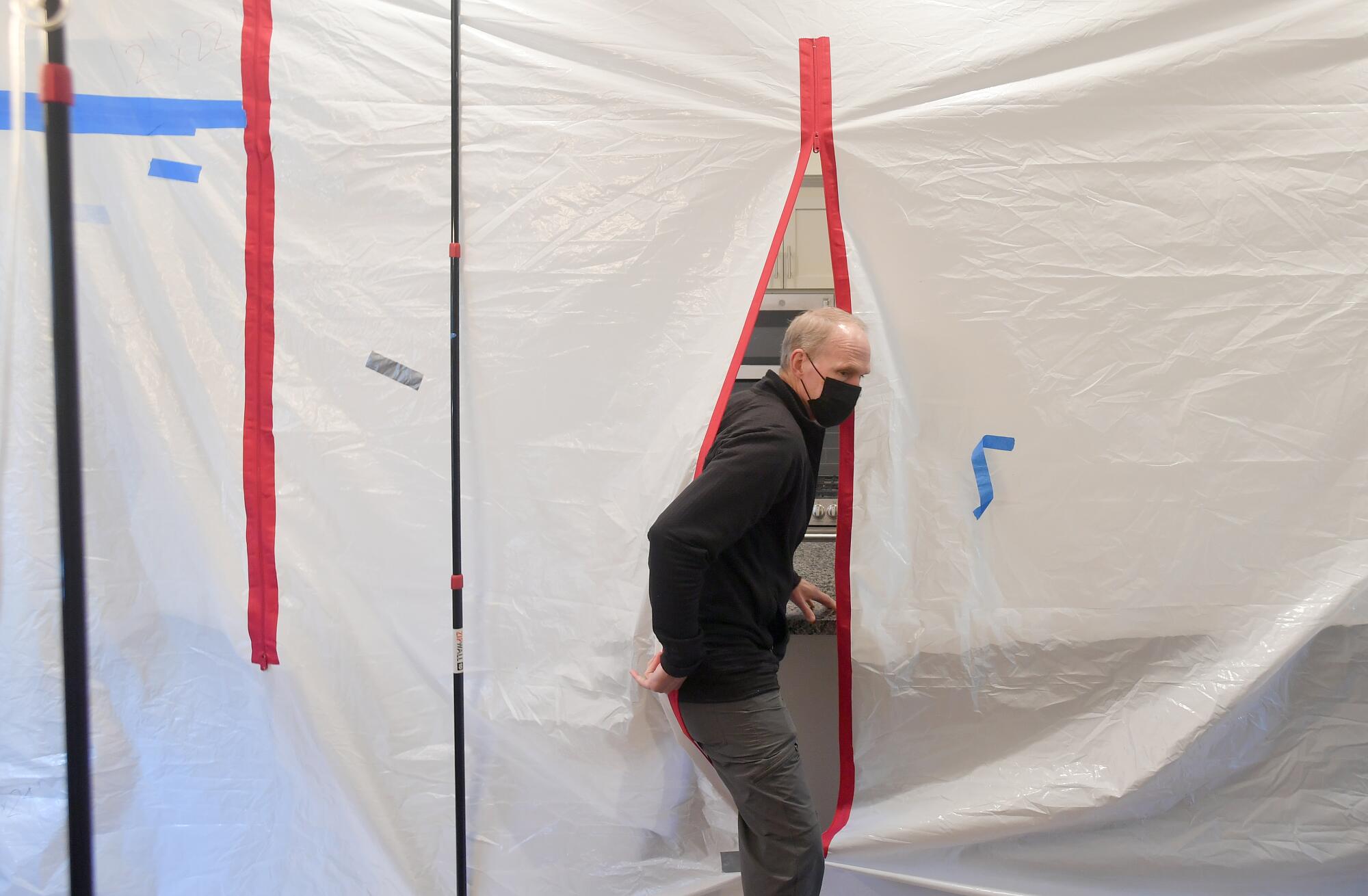
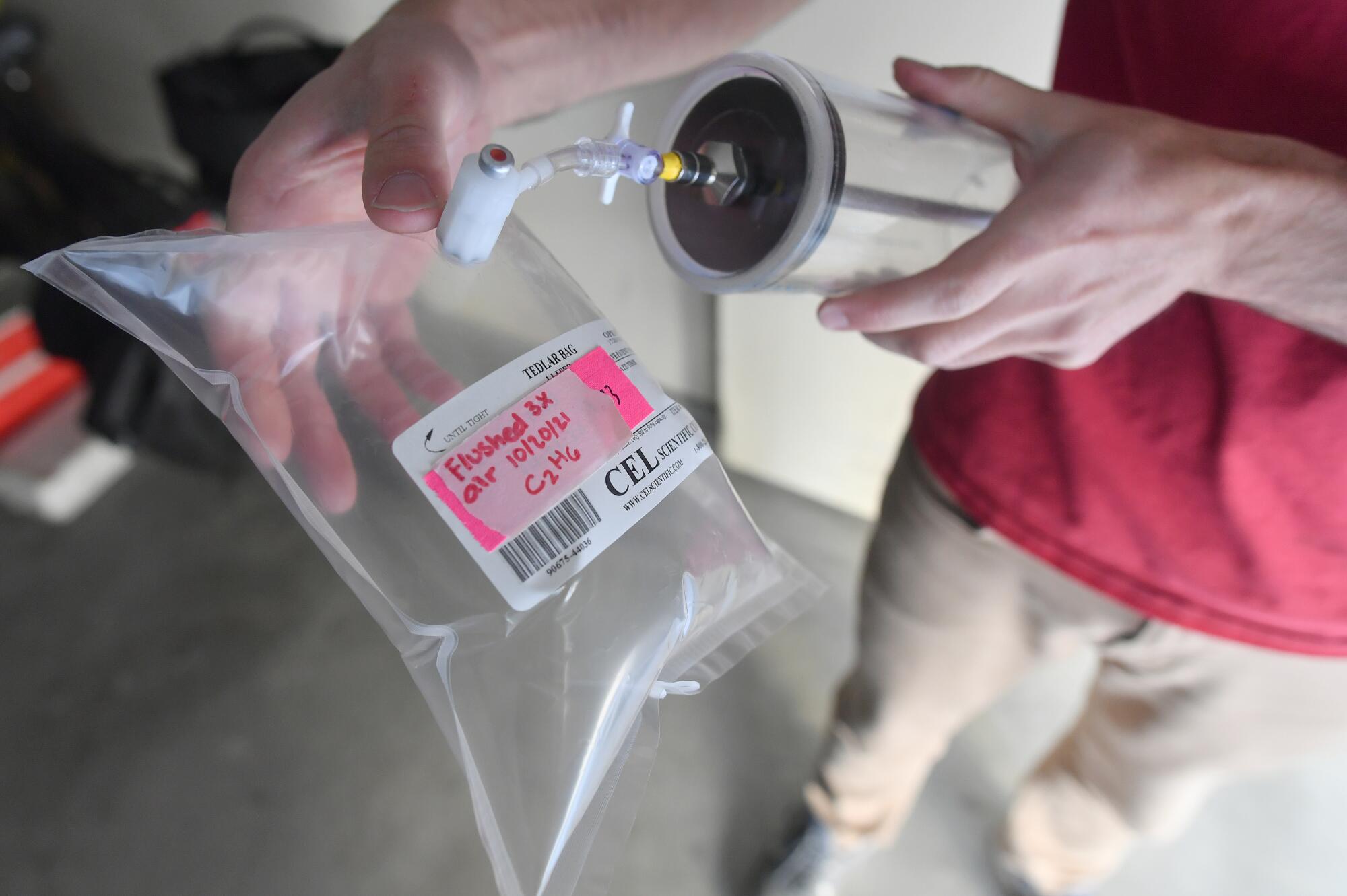
That was the scene playing out recently at a vacant townhouse in Mountain View. Rob Jackson, a Stanford University professor of Earth system science, directed his team to tent off the kitchen with giant sheets of plastic and hook up tubes to the six-burner gas range and oven. As the range silently exhaled invisible gases into the kitchen, Jackson watched his equipment on the other side of the plastic divider for elevated levels of toxic gases, collecting data aimed to fill the research void.
“Surprisingly, there are almost no measurements of how much natural gas leaks into the air from inside homes and buildings,” Jackson said. “It’s probably the part of natural gas usage we understand the least about.”
Climate credits sold to California polluters bring billions to landowners. But scientists ask if that’s an environmental investment or a Ponzi scheme.
Jackson says he is coming at the investigation with an open mind. He says it is possible that more climate-friendly “renewable” natural gas made from organic waste could leave a place for gas appliances in the future, even as a study commissioned by the California Energy Commission found turning off the gas spigots altogether is a more economically viable way to decarbonize homes.
But he has seen enough to turn his exhaust fan on every time he cooks with gas at home — something he did not do previously — and to question why anyone in the market for a new stove right now would buy gas.
“We’re finding pollutants entering the air from using the stoves,” Jackson said. “I just don’t want to breathe NOx [nitrogen oxides] and carbon monoxide and formaldehyde and other gases, even if I don’t know whether they are really a risk to my health or not. … Why not just try to eliminate the risk entirely?”
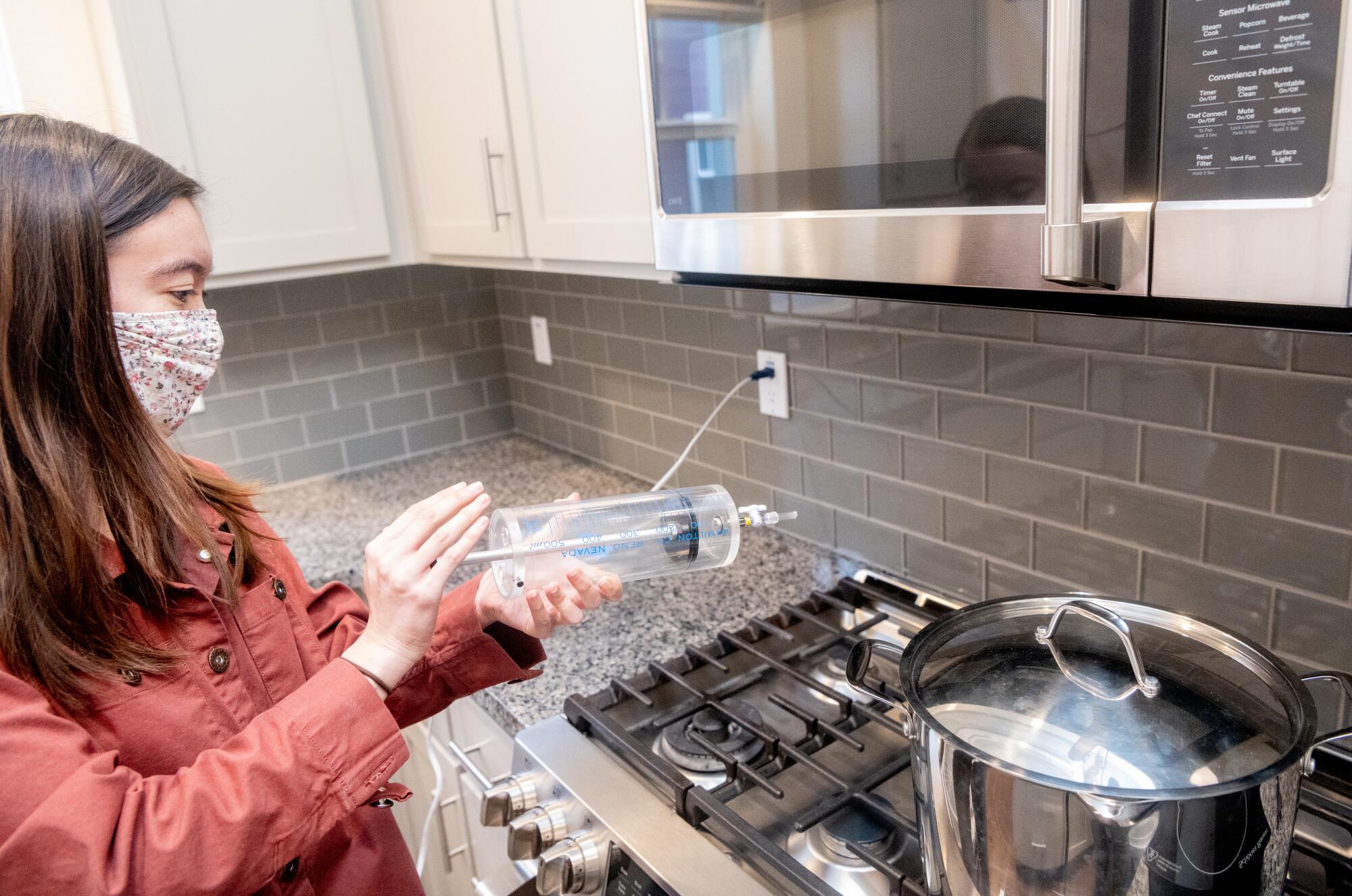
The Stanford team brought a small, portable induction unit to the Mountain View exercise to use as a kind of control — to confirm the pollutants were not coming out of what was being heated on top of the gas stove, but the stove itself. But these plug-in induction hobs are also popping up all over the state, as activists and local governments lend them out as part of an aggressive campaign to wean home chefs from their gas addiction.
“The demystification of electrification is here,” said Bridget Bueche, a Newport Beach chef and appliance advisor who is among a growing group of evangelists for this form of cooking that uses magnets to rapidly heat the pan, instead of the entire burner.
“We can do anything on this,” Bueche said as she seared a steak, caramelized Brussels sprouts and melted chocolate — without a double boiler — on an induction stove inside the Snyder Diamond showroom.
“Most people spend a lot of time waiting for water to boil,” Bueche said as liquid she placed in a pan a minute earlier started to bubble. “We are already at a boil.”
Americans are still getting acquainted with this type of cooking, which caught hold in Europe a while ago. Induction cooktops account for just 5% of stove sales in the U.S. A Morning Consult poll in February found that while more Americans support gas bans than oppose them, induction stoves still aren’t on the radar of most consumers.
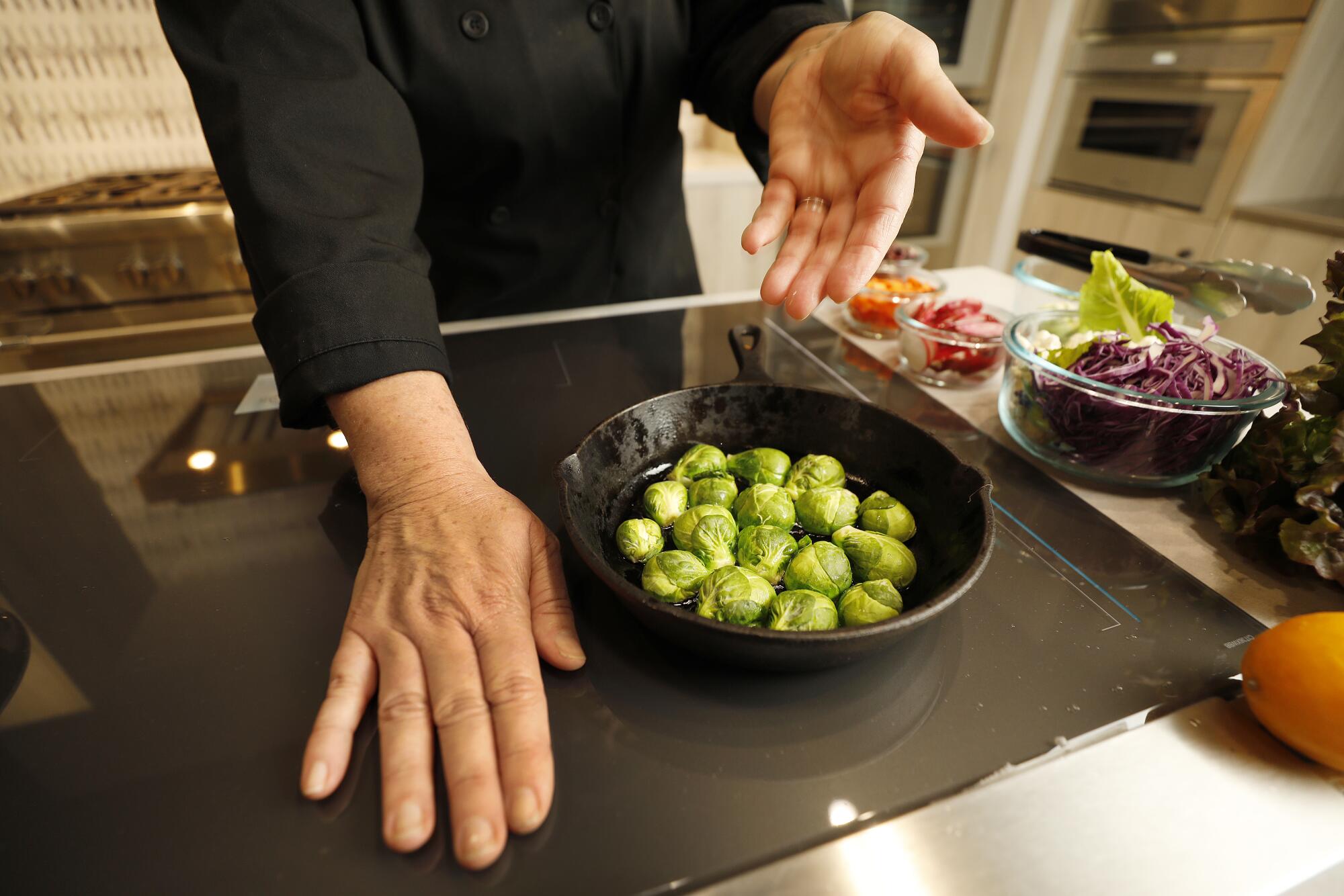
It’s a lot for consumers to wrap their heads around, said Bueche, who compared gas range aficionados to rotary dial telephone loyalists who’ve never held an iPhone.
Electrification enthusiasts are going into people’s homes to train them in the use of the cooktops, and holding well-attended online demonstrations to dispel myths about what you can and cannot do on an induction stove.
After the California Restaurant Assn. unsuccessfully sued to block Berkeley’s ban, arguing it would prevent chefs in Chinese restaurants from using popular high-heat wok cooking methods, celebrity chef and electrification enthusiast Martin Yan went on camera to show off his wok work on an induction stove.
“If we can affect the emotional connection someone has to how they cook their food — if we can click that switch — it is the greatest way to open the conversation of what comes next,” said Lauren Weston, executive director of Acterra, the Bay Area pro-electrification nonprofit that hosted Yan’s demonstration.
The allure of cooking with fire is proving tough competition, built on a foundation of decades of gas industry marketing and a history of electric models that performed poorly.
At Tony P’s Dockside Grill in Marina del Rey, a focal point of the kitchen is the 5-foot charcoal grill, and owner Tony Palermo is hard-pressed to envision how that could be replaced with an electric unit. “The fat drips down on flames, giving you that nice sear on your steak,” he said. “That is not happening with electric. How would you cook steaks? How would you cook pork chops?”

Such concerns have moved several cities to exempt restaurant kitchens from their gas hookup bans — for now. Palermo rattles off a bunch of other headaches he argues that a shift to induction would create. Among them is that the pans in his restaurant — like in most professional kitchens — get so banged up and bent out of shape that they may not even work on an induction cooktop.
Gov. Gavin Newsom promised “giant leaps forward” on climate. But so far state officials haven’t embraced a push to require all-electric buildings.
Some gas industry players have seized on that skepticism with a messaging campaign that leverages their relationships with professional chefs and the myriad nonprofits to which they donate.
As the gas bans began to spread in the spring of 2020, the American Gas. Assn., or AGA, mapped out its strategy for countering them in a leadership call, a recording of which was obtained by the nonprofit Energy and Policy Institute. Its authenticity was confirmed by The Times.
“We’re trying to beat counties and localities from passing bans that then force the hand of governors and state legislators to pass something nascent nationwide,” said Susan Forrester, the AGA’s vice president of advocacy and outreach, during the call. She talked about rallying the AARP, restaurants, builders, laborers and farmers to industry’s side, as well as local mayors, legislators and African American groups “so that we have more friends on our side willing to talk about how great natural gas is.”
Cities moving ahead with gas bans, AGA President and CEO Karen Harbert said in a statement, “have not properly studied the burden it will place on families or the negligible greenhouse gas reduction potential.”
The stakes are so high in this campaign that both sides are using tactics that have become a story in themselves.
A group called Californians for Balanced Energy Solutions, which styled itself as an independent, grass-roots advocacy operation, became a public relations and legal albatross for the Southern California Gas Co. when it was revealed the company was bankrolling the organization with ratepayer funds.
No state has had a bigger impact on the direction of the United States than California, a prolific incubator and exporter of outside-the-box policies and ideas. This occasional series examines what that has meant for the state and the country, and how far Washington is willing to go to spread California’s agenda as the state’s own struggles threaten its standing as the nation’s think tank.
A state Public Advocates Office investigation found numerous pro-gas campaigns were “conceived, designed, and led by SoCalGas often using surrogates to obscure the fact that SoCalGas was responsible.”
The utility inappropriately concealed its role in lobbying campaigns — including those to undermine climate action — made ratepayers shoulder the cost and misled state regulators about all of it, the advocates office said, and it urged the Public Utilities Commission to fine SoCalGas $255 million. The commission agreed that SoCalGas acted inappropriately but has not imposed fines. The utility says that state investigators are violating its 1st Amendment rights and that natural gas is essential to decarbonizing the economy without further destabilizing the power grid.
Not every power company is panicked by the gas hookup bans. Some that provide both electricity and gas, including Pacific Gas and Electric Co. in the Bay Area and Con Edison in New York, support the measures in their areas.
But gas companies have rallied influential allies to their side. On the AGA’s “Cooking With Gas” website, there are testimonials from one chef after another — including some in Southern California — speaking from their kitchens about the virtues of cooking with fire. Many recount horror stories of moments in their careers when only electric cooktops were available. Instagram food influencers and celebrity chefs sponsored by the industry entice their followers with recipes centered around cooking with a flame.
But the scene at the Snyder Diamond showroom suggests the coolness of cooking with fire may be on the wane. Russ Diamond says high-end customers who have been flame-cooking loyalists for decades are gravitating toward high-tech models that use induction.
“People are looking for it now,” he said.
It calls to mind the early days of electric cars, when embrace of Tesla roadsters by early adopters who could otherwise afford the finest combustion engine Porsche or Mercedes sparked a shift in consumer opinion.
The success of the California-driven movement to start shutting the natural gas spigots could hinge on whether the same shift plays out in the kitchen.
More to Read
Get the L.A. Times Politics newsletter
Deeply reported insights into legislation, politics and policy from Sacramento, Washington and beyond. In your inbox three times per week.
You may occasionally receive promotional content from the Los Angeles Times.

